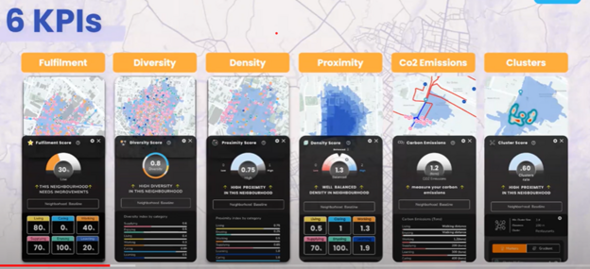KPIs to Measure Urban Performance of 15 Min City
| KPIs to Measure Urban Performance of 15 Min City | |
 KPIs_to_Measure_Urban_Performance_of_15_Min_City.png | |
| Team Organizations | Digital Blue Foam (DBF) |
| Point of Contact | Camiel Weijenberg |
| Participating Municipalities | Many locations |
| Sectors | Buildings Smart Region Transportation |
| Initiative | |
| Status | Implemented |
| Last Updated | December 5, 2025 |
Summary
[[Has description::KPIs to Measure Urban Performance of 15 Min City[2]]]
Digital Blue Foam (DBF) [3]provides an innovative, AI-driven modelling and design tool catered toward facilitating sustainable design. The analytics platform is capable of mapping out the "15-Minute City" concept, a principle that aims to ensure all city dwellers can reach their essential needs within a 15-minute walk or bike ride from their homes. This platform can identify the scope of the 15-minute city principle in virtually any urban location, including larger transportation networks such as biking routes and public transport systems. DBF has formulated a set of six Key Performance Indicators (KPIs) to appraise the effectiveness of a 15-minute city's footprint, otherwise referred to as its "urban performance." The six KPIs are:
- Fulfillment
- Diversity
- Density Proximity
- CO2 Emissions
- Clustering
These KPIs are determined based on six activities: Living, Caring, Working, Supplying, Enjoying, and Learning. Each activity feeds into the overall performance score of the urban area. The score generated provides valuable insights into the quality and distribution of vital city services and amenities. It reveals whether these resources are efficiently allocated to have a substantial impact on the urban environment. Moreover, for urban designers and architects, this rating system serves as a valuable tool in assessing the effectiveness of different design scenarios. Ultimately, this innovative approach contributes to the development of more sustainable, walkable, and comprehensive cities, aligning with the broader goals of urban sustainability and livability. It facilitates better decision-making processes in urban planning, ensuring that cities are designed with accessibility and sustainability in mind.